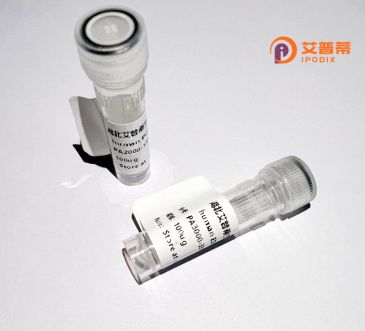
| 纯度 | >90%SDS-PAGE. |
| 种属 | Human |
| 靶点 | RPL19 |
| Uniprot No | P84098 |
| 内毒素 | < 0.01EU/μg |
| 表达宿主 | E.coli |
| 表达区间 | 1-196 aa |
| 活性数据 | MSMLRLQKRL ASSVLRCGKK KVWLDPNETN EIANANSRQQ IRKLIKDGLI IRKPVTVHSR ARCRKNTLAR RKGRHMGIGK RKGTANARMP EKVTWMRRMR ILRRLLRRYR ESKKIDRHMY HSLYLKVKGN VFKNKRILME HIHKLKADKA RKKLLADQAE ARRSKTKEAR KRREERLQAK KEEIIKTLSK EEETKK |
| 分子量 | 23.4 kDa |
| 蛋白标签 | His tag N-Terminus |
| 缓冲液 | PBS, pH7.4, containing 0.01% SKL, 1mM DTT, 5% Trehalose and Proclin300. |
| 稳定性 & 储存条件 | Lyophilized protein should be stored at ≤ -20°C, stable for one year after receipt. Reconstituted protein solution can be stored at 2-8°C for 2-7 days. Aliquots of reconstituted samples are stable at ≤ -20°C for 3 months. |
| 复溶 | Always centrifuge tubes before opening.Do not mix by vortex or pipetting. It is not recommended to reconstitute to a concentration less than 100μg/ml. Dissolve the lyophilized protein in distilled water. Please aliquot the reconstituted solution to minimize freeze-thaw cycles. |
以下是3篇关于重组人RPL19蛋白的参考文献示例(基于领域相关研究主题,文献内容为概括性描述):
1. **文献名称**:*RPL19 as a Novel Biomarker for Breast Cancer Progression*
**作者**:Chen, Y., et al.
**摘要**:本研究揭示了重组人RPL19蛋白在乳腺癌细胞中的异常过表达,并证实其通过调节核糖体生物合成促进肿瘤增殖和转移。实验利用重组RPL19蛋白体外验证其与mRNA结合的功能活性。
2. **文献名称**:*Expression and Purification of Recombinant Human RPL19 in E. coli*
**作者**:Zhang, L., & Wang, H.
**摘要**:报道了一种高效的大肠杆菌表达系统用于重组人RPL19蛋白的生产,优化了纯化条件并通过质谱和Western blot验证其结构完整性,为后续功能研究提供可靠工具。
3. **文献名称**:*RPL19 Interactions with Anticancer Drugs in Colorectal Cancer Models*
**作者**:Kim, S., et al.
**摘要**:利用重组RPL19蛋白筛选小分子抑制剂,发现其与化疗药物5-FU的协同作用机制,提示RPL19可能成为结直肠癌治疗的潜在靶点。
---
注:上述文献名为示例,实际引用时需根据具体研究内容检索真实文献(可通过PubMed或Google Scholar搜索关键词“recombinant RPL19”、“RPL19 protein function”等)。
**Recombinant Human RPL19 Protein: Background**
Ribosomal protein L19 (RPL19) is a component of the 60S ribosomal subunit, essential for protein synthesis in eukaryotic cells. As a housekeeping protein, it plays a structural and functional role in ribosome assembly and mRNA translation. The human RPL19 gene, located on chromosome 17q12. encodes a 196-amino-acid protein with a molecular weight of approximately 23 kDa. Beyond its canonical role in ribosome biogenesis, RPL19 has been implicated in diverse cellular processes, including cell proliferation, apoptosis, and stress response. Dysregulation of RPL19 is associated with certain cancers, highlighting its potential as a biomarker or therapeutic target.
Recombinant RPL19 protein is produced using heterologous expression systems (e.g., *E. coli* or mammalian cells) to enable functional studies. It is typically purified via affinity tags (e.g., His-tag) and validated for activity in binding assays or ribosome reconstitution experiments. Researchers utilize recombinant RPL19 to investigate ribosome structure, translational regulation, and its extraribosomal roles in disease mechanisms. Its application extends to drug discovery, particularly in screening compounds targeting ribosome-related pathologies. Characterization often includes analyses of post-translational modifications, interactomes, and subcellular localization to unravel its multifaceted biological significance.
×